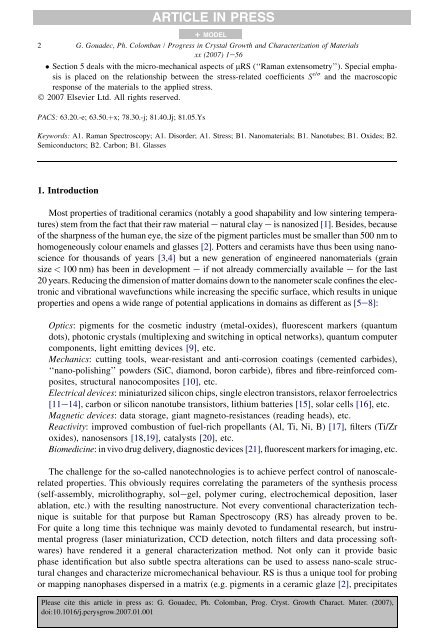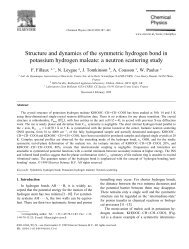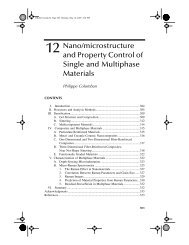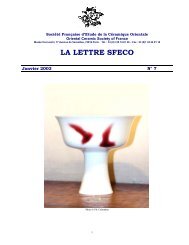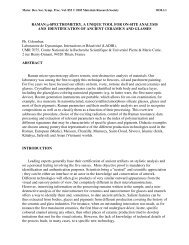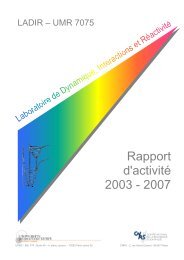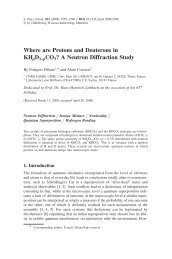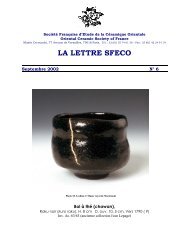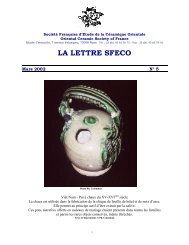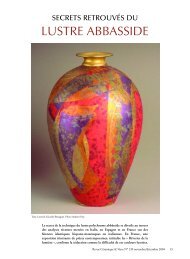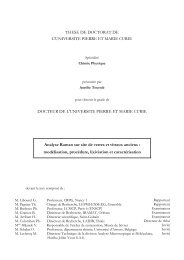Raman Spectroscopy of nanomaterials - institut de chimie et des ...
Raman Spectroscopy of nanomaterials - institut de chimie et des ...
Raman Spectroscopy of nanomaterials - institut de chimie et des ...
You also want an ePaper? Increase the reach of your titles
YUMPU automatically turns print PDFs into web optimized ePapers that Google loves.
+ MODEL2 G. Goua<strong>de</strong>c, Ph. Colomban / Progress in Crystal Growth and Characterization <strong>of</strong> Materialsxx (2007) 1e56 Section 5 <strong>de</strong>als with the micro-mechanical aspects <strong>of</strong> mRS (‘‘<strong>Raman</strong> extensom<strong>et</strong>ry’’). Special emphasisis placed on the relationship b<strong>et</strong>ween the stress-related coefficients S 3/s and the macroscopicresponse <strong>of</strong> the materials to the applied stress.Ó 2007 Elsevier Ltd. All rights reserved.PACS: 63.20.-e; 63.50.þx; 78.30.-j; 81.40.Jj; 81.05.YsARTICLE IN PRESSKeywords: A1. <strong>Raman</strong> <strong>Spectroscopy</strong>; A1. Disor<strong>de</strong>r; A1. Stress; B1. Nanomaterials; B1. Nanotubes; B1. Oxi<strong>de</strong>s; B2.Semiconductors; B2. Carbon; B1. Glasses1. IntroductionMost properties <strong>of</strong> traditional ceramics (notably a good shapability and low sintering temperatures)stem from the fact that their raw material e natural clay e is nanosized [1].Besi<strong>de</strong>s,because<strong>of</strong> the sharpness <strong>of</strong> the human eye, the size <strong>of</strong> the pigment particles must be smaller than 500 nm tohomogeneously colour enamels and glasses [2]. Potters and ceramists have thus been using nanosciencefor thousands <strong>of</strong> years [3,4] but a new generation <strong>of</strong> engineered <strong>nanomaterials</strong> (grainsize < 100 nm) has been in <strong>de</strong>velopment e if not already commercially available e for the last20 years. Reducing the dimension <strong>of</strong> matter domains down to the nanom<strong>et</strong>er scale confines the electronicand vibrational wavefunctions while increasing the specific surface, which results in uniqueproperties and opens a wi<strong>de</strong> range <strong>of</strong> potential applications in domains as different as [5e8]:Optics: pigments for the cosm<strong>et</strong>ic industry (m<strong>et</strong>al-oxi<strong>de</strong>s), fluorescent markers (quantumdots), photonic crystals (multiplexing and switching in optical n<strong>et</strong>works), quantum computercomponents, light emitting <strong>de</strong>vices [9], <strong>et</strong>c.Mechanics: cutting tools, wear-resistant and anti-corrosion coatings (cemented carbi<strong>de</strong>s),‘‘nano-polishing’’ pow<strong>de</strong>rs (SiC, diamond, boron carbi<strong>de</strong>), fibres and fibre-reinforced composites,structural nanocomposites [10], <strong>et</strong>c.Electrical <strong>de</strong>vices: miniaturized silicon chips, single electron transistors, relaxor ferroelectrics[11e14], carbon or silicon nanotube transistors, lithium batteries [15], solar cells [16], <strong>et</strong>c.Magn<strong>et</strong>ic <strong>de</strong>vices: data storage, giant magn<strong>et</strong>o-resistances (reading heads), <strong>et</strong>c.Reactivity: improved combustion <strong>of</strong> fuel-rich propellants (Al, Ti, Ni, B) [17], filters (Ti/Zroxi<strong>de</strong>s), nanosensors [18,19], catalysts [20], <strong>et</strong>c.Biomedicine: in vivo drug <strong>de</strong>livery, diagnostic <strong>de</strong>vices [21], fluorescent markers for imaging, <strong>et</strong>c.The challenge for the so-called nanotechnologies is to achieve perfect control <strong>of</strong> nanoscalerelatedproperties. This obviously requires correlating the param<strong>et</strong>ers <strong>of</strong> the synthesis process(self-assembly, microlithography, solegel, polymer curing, electrochemical <strong>de</strong>position, laserablation, <strong>et</strong>c.) with the resulting nanostructure. Not every conventional characterization techniqueis suitable for that purpose but <strong>Raman</strong> <strong>Spectroscopy</strong> (RS) has already proven to be.For quite a long time this technique was mainly <strong>de</strong>voted to fundamental research, but instrumentalprogress (laser miniaturization, CCD <strong>de</strong>tection, notch filters and data processing s<strong>of</strong>twares)have ren<strong>de</strong>red it a general characterization m<strong>et</strong>hod. Not only can it provi<strong>de</strong> basicphase i<strong>de</strong>ntification but also subtle spectra alterations can be used to assess nano-scale structuralchanges and characterize micromechanical behaviour. RS is thus a unique tool for probingor mapping nanophases dispersed in a matrix (e.g. pigments in a ceramic glaze [2], precipitatesPlease cite this article in press as: G. Goua<strong>de</strong>c, Ph. Colomban, Prog. Cryst. Growth Charact. Mater. (2007),doi:10.1016/j.pcrysgrow.2007.01.001


